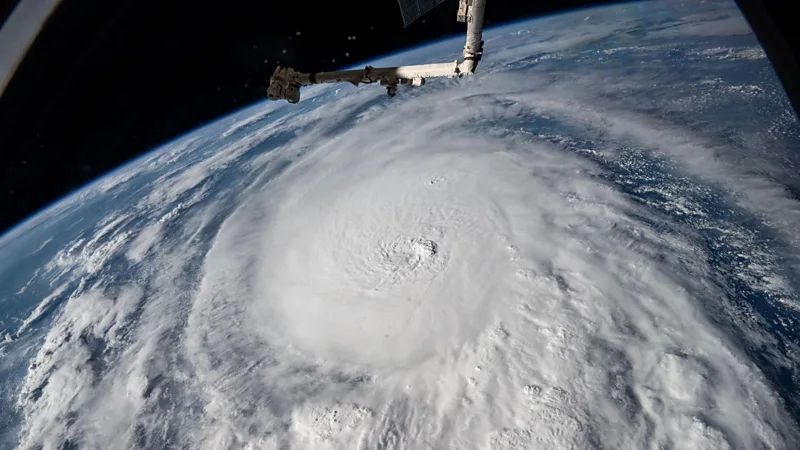Between the dark hours of 9 p.m. – 1 a.m. EST, Florida residents braced themselves for another catastrophe. Entire towns were abandoned, debris left behind, and homes vacated. Those watching from the screens urge friends and family to get out, get safe, and stay alive.
Hurricane Milton made landfall on central Florida’s west-coast as a Category 3 hurricane in the evening hours of Wednesday. It traveled across the state, spawning 20 confirmed tornadoes. Those who evacuated inland were still hit with massive rainfall and flooding, high winds and power outages.
The once tropical storm took less than 36 hours to strengthen into a Cat 5, but slowed and downgraded to a Cat 3 upon approaching the state. The storm spanned hundreds of miles, swiping across the entire peninsula.

AP Photo/X/@StuOstro
Satellite radar footage of Hurricane Milton resembles a skull as it was expected to hit Tampa on Wednesday night and Thursday morning.
Hurricanes are rated on a 1-5 scale based on top wind speed. Major hurricanes begin with Cat 3, with wind speeds between 111-130 mph. Cat 5 hurricanes are anything with wind speeds 156 mph or more.
Cat 5 hurricanes rip trees out of the ground, cause intense property damage, and lead to days without power.
Tampa Mayor Jane Castor released a chilling statement, “If you choose to stay in one of those areas, you are going to die… Wherever that storm surge comes, if it’s 10 to 15 feet, and people are trying to ride this out in single story structures, there’s no place to go… It is the water that we have got to run from.”
Castor urged families to get to higher ground.
The eyewall approached the Sarasota area, just south of Tampa, around 7 p.m. EST, yet the region had been experiencing rain and wind for hours prior as the storm rolled in. Hurricane Milton also brought in isolated tornadoes across the flat plateau. These caused damage in Fort Meyers earlier Wednesday.
Jim Cantore, Florida-trusted hurricane expert, arrived in Tampa Tuesday to cover the storm. It highlighted two interesting indexes that civilians in the state often refer to when gauging hurricane danger: the Waffle House Index and the Cantore Appearance.
“If you’re in one of those evacuation zones, all the way from Pasco county to Fort Myers, I hope you have left,” Cantore said while covering the storm for The Weather Channel at 8 PM EST.
Mavrie Durham, who resided in Pasco county, just north of St. Petersburg, before moving to Seatac and attending Highline College, continued to receive emergency calls and texts from her previous home calling for mass evacuations.

Fox5 Weather
Hurricane Milton’s path across Florida.
At 4:20 p.m. PST, Durham received an alert stating, “Pasco County has suspended all emergency service responses.”
Her friends and family still remain in the area, as evacuations following Helene become fiscally and logistically impossible. Highways, back roads, and bridges are gridlocked with traffic all across central Florida. Gas stations have run out of fuel, and many have abandoned their cars in an effort to escape the water.
The city of Tampa began taking on flooding as the storm rolled in. Tampa General Hospital lifted its Flood Wall again, a reusable wall used to fight off storm surge successfully during Helene.
Just days prior, resource station and comfort center alerts erupted in the wake of Hurricane Helene. They have since been shut down in anticipation of Milton.
Under two weeks ago, the region was slammed by Hurricane Helene, a Cat 4 storm, with sustained wind speeds of 130 mph and gusts of up to 155 mph. Helene thundered into Florida’s big bend region, cut up through Georgia, and decimated western North Carolina.
Milton continued eastwards after making landfall, hopping over the Florida peninsula instead of going after surrounding states like Helene.

Fox5 Weather
Hurricane Helene’s path through north Florida and into the Southeast United States.
Due to a continuous storm front that soaked the region for days prior, once Helene reached North Carolina as a tropical storm, 400 miles away from where it made landfall, the mountain rivers overflowed with mud, carrying away roads, homes, and people.
It could be months before we know the total loss of life from Hurricane Helene. FEMA, the National Guard, and other non-profits are working around the clock to recover missing persons, restore access to rural and cut-off areas, and establish contact with families.
In the past century, only 42 tropical cyclones have reached Category 5 status, most notably the devastating Hurricane Katrina of 2008. Currently, there is another tropical depression forming in the Atlantic Basin, Tropical Storm Nadine, with the potential to form into yet another major storm as it approaches land.
Hurricanes form under warm-ocean cool-air conditions. Due to global warming, the ocean is warmer than ever, which provides perfect conditions for the malevolent storms.
John Morales, a meteorologist in South Florida, choked up on air the other day discussing the effect of global warming. While discussing rapid and unprecedented change in behavior, the scientist sniffed and said, “I’m sorry. It’s just horrific.”

Spencer Platt/Getty Images
The roof at Tropicana Field, the home of the Tampa Bay Rays, sustained major damage because of high winds associated with Hurricane Milton on Oct. 10 in St. Petersburg, Fla.

